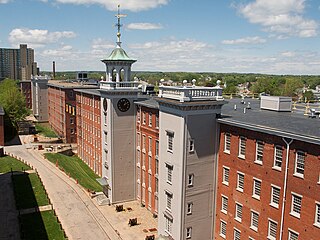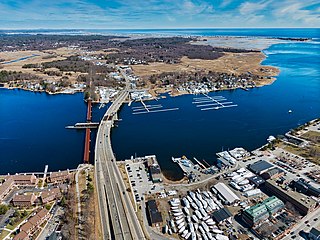| Amoskeag Falls | |
|---|---|
 | |
 | |
| Location | Manchester, New Hampshire, United States |
| Coordinates | 43°00′08″N71°28′22″W / 43.00222°N 71.47278°W |
The Amoskeag Falls are a set of waterfalls on the Merrimack River in Manchester, New Hampshire, United States.
| Amoskeag Falls | |
|---|---|
 | |
 | |
| Location | Manchester, New Hampshire, United States |
| Coordinates | 43°00′08″N71°28′22″W / 43.00222°N 71.47278°W |
The Amoskeag Falls are a set of waterfalls on the Merrimack River in Manchester, New Hampshire, United States.
"Amoskeag" derives from the Pennacook Native American word "Namoskeag", which roughly translates as "good fishing place". Here, the Merrimack River drops 50 feet (15 m) over the course of 0.25 miles (0.40 km). [1] Local tribes in the region fished Amoskeag Falls for its plentiful migrating sturgeon, alewife, and salmon, which were easily caught in the rapids. Natives typically used a combination of large nets strung across the river. Significant native settlements were sited near the falls, particularly on the high bluffs overlooking the east side of the river.
In 1807, Samuel Blodgett started a canal and lock system at the river to help vessels navigate around the falls, opening the area to development. This soon led to the use of the falls for a power canal to provide water power for Manchester's 19th century industrial development, most notable for the Amoskeag Manufacturing Company. [2]
Due to the significance of the falls in Manchester history, a number of local companies have adopted their name. Examples include the Amoskeag Manufacturing Company (which operated a majority of Manchester's textile mills using power from the falls until they closed in the midst of labor strikes in 1935), its division called the Amoskeag Locomotive Works (an early manufacturer of fire trucks and train cars), and the Amoskeag Fishways (an environmental education center located at the Amoskeag Falls).

Manchester is the most populous city in the U.S. state of New Hampshire and in northern New England. At the 2020 census, it had a population of 115,644.

Lowell National Historical Park is a National Historical Park of the United States located in Lowell, Massachusetts. Established in 1978 a few years after Lowell Heritage State Park, it is operated by the National Park Service and comprises a group of different sites in and around the city of Lowell related to the era of textile manufacturing in the city during the Industrial Revolution. In 2019, the park was included as Massachusetts' representative in the America the Beautiful Quarters series.

The Merrimack River is a 117-mile-long (188 km) river in the northeastern United States. It rises at the confluence of the Pemigewasset and Winnipesaukee rivers in Franklin, New Hampshire, flows southward into Massachusetts, and then flows northeast until it empties into the Gulf of Maine at Newburyport. From Pawtucket Falls in Lowell, Massachusetts, onward, the Massachusetts–New Hampshire border is roughly calculated as the line three miles north of the river.

Hooksett is a town in Merrimack County, New Hampshire, United States. The population was 14,871 at the 2020 census, up from 13,451 at the 2010 census. The town is located between Manchester, the state's largest city, and Concord, the state capital. A prominent landmark is Robie's Country Store, a National Historic Landmark and a frequent stop for presidential candidates during the New Hampshire primary.
A mill town, also known as factory town or mill village, is typically a settlement that developed around one or more mills or factories, often cotton mills or factories producing textiles.

Completed in 1796, the Pawtucket Canal was originally built as a transportation canal to circumvent the Pawtucket Falls of the Merrimack River in East Chelmsford, Massachusetts. In the early 1820s it became a major component of the Lowell power canal system. with the founding of the textile industry at what became Lowell.
Amoskeag may refer to:

The Nashua Manufacturing Company was a cotton textile manufacturer in Nashua, New Hampshire, that operated from 1823 to 1945. It was one of several textile companies that helped create what became the city of Nashua, creating roads, churches and its own bank as part of the process. Like most New England textile mills it struggled during the Depression. It shut in 1947, when much of the industry had moved South for cheaper labor and land.

The Amoskeag Manufacturing Company was a textile manufacturer which founded Manchester, New Hampshire, United States. From modest beginnings it grew throughout the 19th century into the largest cotton textile plant in the world. At its peak, Amoskeag had 17,000 employees and around 30 buildings.

A power canal is a canal used for hydraulic power generation, rather than for transport of watercraft. The power canal was a major factor in the Industrial revolution in New England in the 19th century. Most early power canals were mill races used mechanically to transfer power directly from falling water to machinery in mill buildings. Later, the hydraulic power generated electricity locally for the same mill factories. These power canals were often filled in as electricity replaced the need for local water power, and road transport needs or city expansion needs reclaimed the land. Some hydraulic power canals were transformed into local electric generators, but most were closed. Remains of power canals can be seen in old mill towns and are often protected as historical structures today.
The history of Lowell, Massachusetts, is closely tied to its location along the Pawtucket Falls of the Merrimack River, from being an important fishing ground for the Pennacook tribe to providing water power for the factories that formed the basis of the city's economy for a century. The city of Lowell was started in the 1820s as a money-making venture and social project referred to as "The Lowell Experiment", and quickly became the United States' largest textile center. However, within approximately a century, the decline and collapse of that industry in New England placed the city into a deep recession. Lowell's "rebirth", partially tied to Lowell National Historical Park, has made it a model for other former industrial towns, although the city continues to struggle with deindustrialization and suburbanization.
Head v. Amoskeag Mfg. Co., 113 U.S. 9 (1885), was a U.S. Supreme Court case considering whether a dam constructed on privately owned land served a public purpose and whether having the owner of the dam compensate any adjacent landowner was a legal form of eminent domain.

Mill Conversion or mill rehab is a form of adaptive reuse in which a historic mill or industrial factory building is restored or rehabilitated into another use, such as residential housing, retail shops, office, or a mix of these non-industrial elements (mixed-use).

District A is a historic worker housing district located in Manchester, New Hampshire, near the former Amoskeag Manufacturing Company millyard. It is bounded by Pleasant, State, Granite, and Bedford streets, and includes seven surviving tenement blocks built by Amoskeag between 1843 and 1852. The district was added to the National Register of Historic Places on November 12, 1982.

District B is a historic worker housing district located in Manchester, New Hampshire, United States, near the former Amoskeag Manufacturing Company millyard. It is roughly bounded by Canal, Mechanic, Franklin, and Pleasant Streets, and was added to the National Register of Historic Places on November 12, 1982. It contains 32 contributing properties, including seventeen rowhouse tenement blocks built mainly between 1838 and 1850, in an area of approximately 170 acres (69 ha).

District C is a historic worker housing district located in Manchester, New Hampshire, near the former Amoskeag Manufacturing Company millyard, and surrounding area. It is roughly bounded by N. Hampshire Lane, Hollis, Canal, and Bridge streets, and was added to the National Register of Historic Places on November 12, 1982. It originally contained nine rowhouses in an area of approximately 5 acres (2 ha); three have subsequently been demolished and replaced by an apartment complex.

District D is a historic worker housing district located in Manchester, New Hampshire, near the former Amoskeag Manufacturing Company millyard. It is roughly bounded by Canal, Langdon, Elm, and West Brook streets, and was added to the National Register of Historic Places on November 12, 1982. It contains three residential buildings constructed in 1864 in an area of about 3 acres (1 ha).

The Merrimack Valley is a bi-state region along the Merrimack River in the U.S. states of New Hampshire and Massachusetts. The Merrimack is one of the larger waterways in New England and has helped to define the livelihood and culture of those living along it for millennia.

The Thomas Russell Hubbard House is a historic house at 220 Myrtle Street in Manchester, New Hampshire. The 2½-story wood-frame house was built in 1867, by a farmer turned businessman and a prosperous owner of a factory and lumberyard, and is an exceptionally elaborate Italianate villa. It was listed on the National Register of Historic Places in 1988.

Samuel Blodgett was an early American lawyer, industrialist, and financier who founded the city of Manchester, New Hampshire.